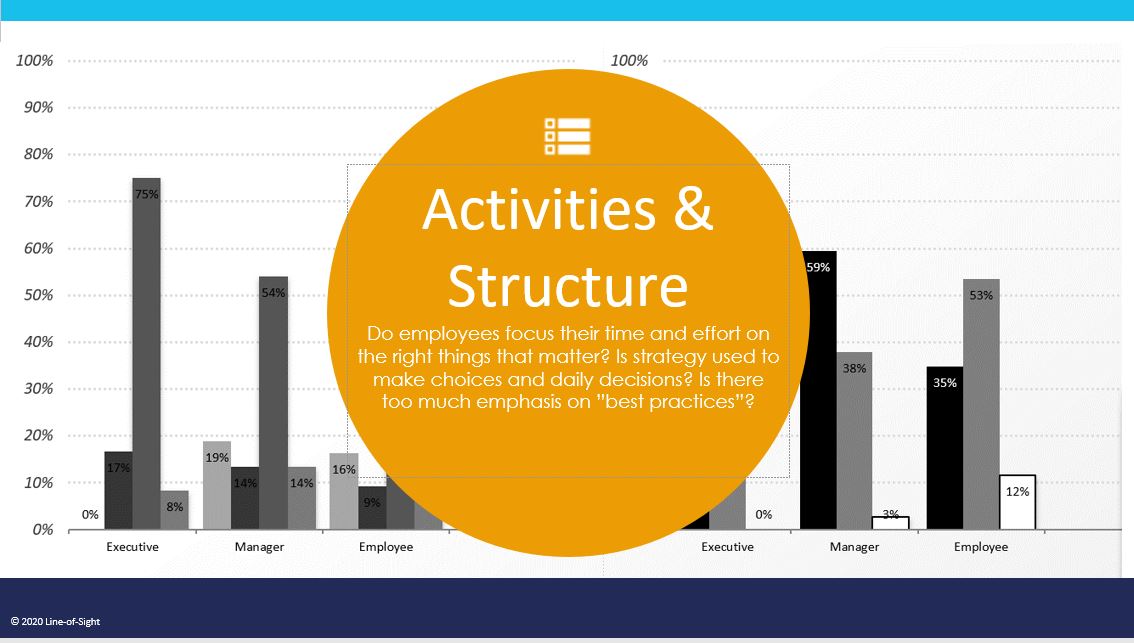The Importance of Activities and Structure
Execution is the sum of all the activities and tasks performed by your employees. This is where the rubber hits the road. These activities and tasks must be directly relevant to your strategy.
On paper, your processes and roles may be finely tuned and exactly what you need to execute. In the reality of the field, the actual tasks that employees perform may be very different from what the management thinks is happening.
Sometimes that gap happens for good reason: employees may use a workaround to accommodate a unique supplier or an old system’s limitations. But often, employees are required to perform tasks with no value or tasks which are downright at odds with your strategy. A poorly chosen metric may drive undesirable behavior, a process may have been designed without considerations for upstream or downstream constraints, or a manager misinformed of the company’s strategy may have asked for specific activities that contradict the organization’s market positioning.
In a famous (and real) example, a new manager asked drivers for a furniture delivery company to buy a rose to give to each client and to conduct a detailed satisfaction interview. It would have been suitable for a high-end store, but this one was built on low prices and high efficiency, and these new tasks understandably slowed down delivery schedules, dramatically hurt already thin margins, and muddied the store brand.
| Are your activities and structure consistent with your strategy and positioning? Consider the questions below. If you answer “no” at least once, you would be well-served to scrutinize the major activities being performed by your employees and weigh them against your strategy. If employees were asked, would they say that they spend their daily efforts only on tasks that are critical? Is your strategy a clear guide to help employees prioritize their daily activities and priorities? Do all employees clearly see the connection between their work and customer value?Is individual decision-making systematically encouraged? |
Our clients use Line-of-SightSM to get an unvarnished assessment of how much tasks and activities performed by your employees are actually relevant to execute your strategy.
This is where you improve productivity: not by having employees work faster, but by rigorously eliminating superfluous tasks that do not directly contribute to your strategy.
There are big implications to this approach: first, you must communicate your strategy in clear and simple terms to all employees (hence the importance of strategic understanding as an execution driver). This is the only way for employees to assess whether the activities they perform add value.
Second, you must empower employees to make decisions, so that they have the leeway to focus only on those activities that are aligned with your goals. Of course, that also requires information to flow openly, because employees must also prioritize their tasks by considering how they fit in the broader operations.
Finally, your structure must aggregate and organize activities in a way that makes sense for your strategy. Elon Musk famously remarked that poor service delivery or product design often reflect breakpoints between functions or teams in the organization.
Michael Porter summarized it best, “The essence of strategy lies in choosing what NOT to do”. This applies to activities too: your role as a leader is to ruthlessly fight “task inflation,” the natural tendency for human organizations to do more rather than less and to lose track of what is important. When you do less, your employees better focus on what matters and how their contribution to the bigger strategy is plainly visible, which in turn motivates them and raises productivity.
In our next blog, we will consider attracting and retaining Human Capital.
How well is your business executing? To find out, please reach and we will initiate an assessment of your execution capabilities. Reach us at info@kinseymgmt.com


